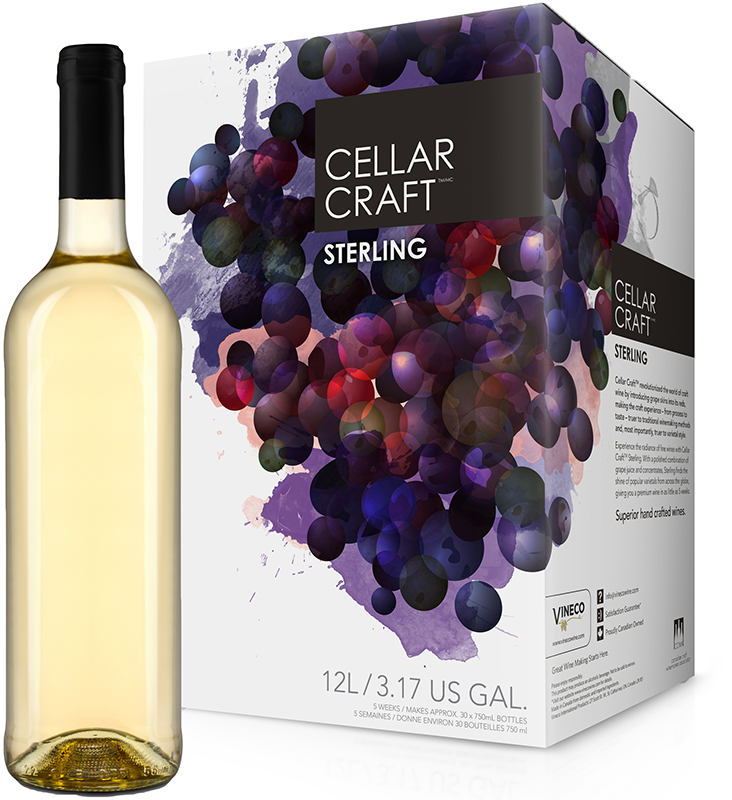 Hi everyone!
Hi everyone!
I’m so excited I’m finally giving that Cellar Craft Sterling California Chardonnay another go! If you recall, the last time I started this wine making ingredient kit I totally screwed up with the fermentation temperature. It was too cool. I didn’t really catch the error until it was too late. I tried to resurrect it, but alas, it was not to be.
This time I came prepared with my fermenter heating pad and barring any long-term power outages here in Colorado (knock on wood), I shouldn’t run into that problem again!
I find it so funny that I need to use a heating element when it’s been about 90 degrees outside for the past two weeks, but at least I know that my basement is a great place to hang out if I get too warm! I keep the air conditioning running but even though I have the vents closed to the wine room, it’s still a lot cooler down there than the rest of the house, necessitating the use of the heating pad basically all year round. That’s OK with me though – whatever keeps the temperature steady makes me happy!
Anyway, I decided today’s the day I’ll be starting a wine making ingredient kit. So I pulled out the directions that came with the wine kit and got to work. I mixed together some hot water and the bentonite packets. Gotta love that clay smell! Then, I added in the wine base (love the smell of the juice!) and enough water to bring the total volume up to 23L/6gallons.
At this point, I checked the specific gravity with my wine hydrometer, and it was 1.100 at about 74°F. Running that through an online temperature corrector for the calibration temperature of my hydrometer, the specific gravity was about 1.101. At this little of a difference, I wonder if it really matters if I even do the correction. I suppose if it were borderline and I had to decide whether or not to move forward based on that value, I’d certainly want to do it. But for calculating the alcohol content at the end, I don’t think it’ll matter too much, especially since I’m not selling this to anyone!
After the specific gravity reading, I added the oak shavings, gave it a stir, then sprinkled the wine yeast on the top.
I plugged in the heating pad, covered the primary fermenter, and said a silent prayer that this batch wouldn’t turn out the way the first one did! I have a better feeling about this one, so fingers crossed it all comes out the way it is supposed to!
That’s really all there is to starting a wine making ingredient kit. Now I just sit and wait for 6-8 days before checking the specific gravity again to determine if the wine is ready to move on to secondary fermentation. I have learned my lesson from last time, however, and I will be at least poking my head in daily to make sure the yeasts are doing their thing and fermenting!
———————————–
 My name is Leigh Erwin, and I am a brand-spankin’ new home winemaker! E. C. Kraus has asked me to share with you my journey from a first-time dabbler to an accomplished home winemaker. From time to time I’ll be checking in with this blog and reporting my experience with you: the good, bad – and the ugly.
My name is Leigh Erwin, and I am a brand-spankin’ new home winemaker! E. C. Kraus has asked me to share with you my journey from a first-time dabbler to an accomplished home winemaker. From time to time I’ll be checking in with this blog and reporting my experience with you: the good, bad – and the ugly.

I started making wine about 8 or 9 years ago. A great hobby and even though I still make mistakes, it is enjoyable. Keep up the experimentation.
Hi, I had a slimmer problem, ,i lost wine & i live in az & the temp was too hot, what i came up with is a Tupperware container ( big enough for the carboy or plastic container,), a aquarium heater( one that u can regulate the temp ,about $20.000 ,never had a problem since . best of luck
lou